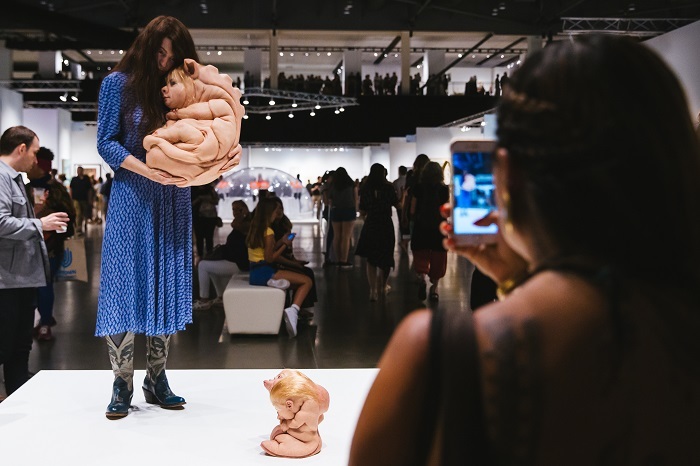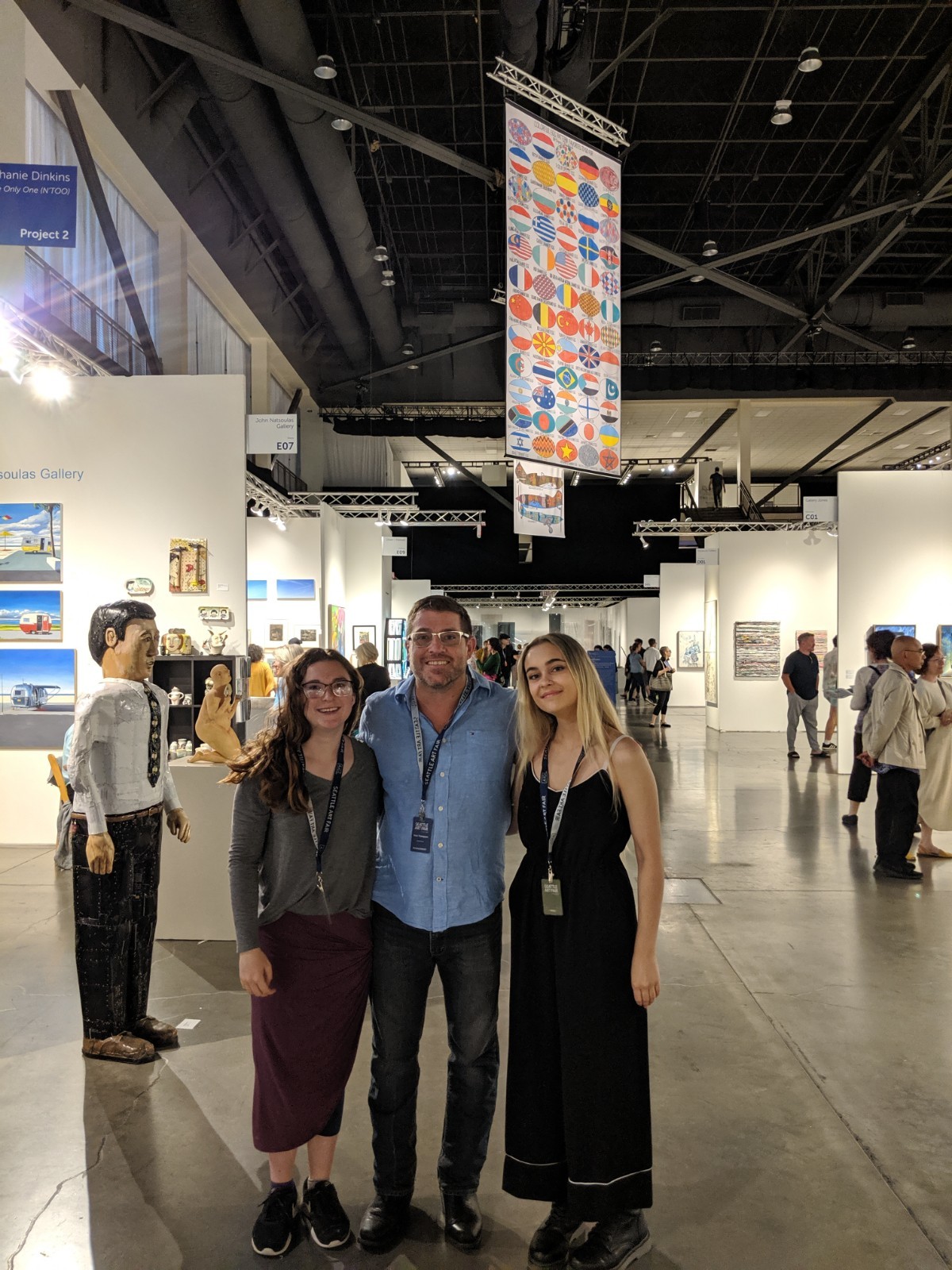Discussing Wunderkammers and “A Deep Fear of Crappy Jobs”
Interview with Seattle Art Fair curator and artistic director Nato Thompson.
Written by TeenTix Press Corps writer Sitara Lewis.

Fellow TeenTix Press Corps writer, Rosemary Sissel, and I were honored to interview Seattle Art Fair’s curator and artistic director, Nato Thompson. The Seattle Art Fair 2019 took place at Centurylink Field Event Center August 1-4.
You’ve attempted to create a wide array of different objects and pieces of art and magic that evokes the curiosity rooms of the 16th and 17th centuries, and reading your curatorial statement, it’s almost as if these rooms contained everything. So how is it possible to curate everything?
The answer is that it is not possible. You can’t curate everything. And...in kind of a fun way, the cabinet of curiosities are sort of grabbaggy, you know? Everything can kind of fit in. These cabinets of curiosities, these wunderkammers are more like people’s collections of stuff. And it was like stuff they picked up on their travels, it was generally men, white. Sometimes like a unicorn horn, sometimes like a piece of art. I think of art as a metaphoric way to think through the world, and I’m interested in artists that do that. And so I think the wunderkammers are a beautiful space because it’s undifferentiated in its disciplines. I nevertheless will say this: I’m also interested in having a counter narrative, not even for myself, but for the artists in terms of colonialism, in terms of race, in terms of gender, in terms of sexuality, so there’s different artists and different interests who I think come at their interdisciplinary questions with a critic of these things.
How did you start curating, and how has it influenced your outlook on the world?
Sure, so I had no career sense most of my life. I got through undergraduate at Berkeley, and I wanted to be a professional anarchist. But I lived in a warehouse with friends, and we did events all the time. So we had hip hop bands play, we’d have like activists from the Zapatistas in the South of Mexico come up and do talks in our space. We’d have film nights. We had all these things. But I didn’t think of that as a job. It was just what I loved to do. But while I was doing that, I was working at Kinko's copies. Basically I worked on photocopiers all the time, and it was like the worst job on the planet. And so, what inspired me to get into the arts was total depression over other fields. And I was like what do I do? I was just like “I’m terrible at everything!” And then I was like well I am good at getting really weird people to do things together. And I was like, “That’s a job?” “Yeah, it’s called curating!” So I went to grad school at the Arts Institute of Chicago and I was determined to work in a field that I loved. But it was motivated by a deep fear of crappy jobs. And a deep love for art and artists, too.

What are one or two exhibits that you think best represent the Seattle Art Fair?
Ultimately, the goal is to produce a compelling experience for people. There’s that piece by Patricia Piccinnini which is the mother holding the mutant baby. [The piece he is referring to is titled “The Bond and the Loafers”]. That I like because it’s gendered, it’s mutant, it’s post human, it’s not freakish. It’s sensitive. It’s biological. I really enjoy it in a lot of ways…. There’s also the really phenomenal project by Stephanie Dinkins, which is called “N’TOO.” And you can interact with it. It’s an artificial intelligence creature ...programmed with three generations of African American history in it. Everytime I come to Seattle I have some sort of critique of white tech. And she’s really interested in an AI that’s not connected to the grid, that’s not connected to the cloud. That comes up with its own knowledge systems. When you talk to it, it’s very non-sequitur-ish at times. But it is an AI program. And it’s learning from you as you talk to it. Dinkins is really interested in exploring alternate forms of knowledge and technology that I find has a lot to offer. And it’s weird!”
What’s the importance of AI for humanity? Why’d you choose to talk about it in this way?
Technology is a weird thing. Because it’s both embedded in a lot of hope and a lot of power. You know in those commercials they are like, “The future is tech”? But a lot of people in Indigenous cultures say raising a kid is a way of technology. Ways of raising corn is a technology. Ways of dealing with each other is a technology. We’ve somehow made technology about gizmos and gadgets. It’s really embedded in a kind of capitalist manufacturing methodology, and, I find, some of the underlying premises of that, are deeply destroying this planet. And the unbridled ambition that is attached to this white progress... until the engine reverses on the machine that’s been unleashed, I don’t think it’s too bad to critique it constantly.

What advice would you give to youth that want to be involved in the contemporary art scene, and how do you think it could be more welcoming and accessible?
The arts are amazing and the best way to get into the arts is to make art and hang out with people that make art. Art’s fun! Hang out with any five year old. They’re pure art. It’s the weirdest thing to me because I got into art also because I didn't want to be around the jocks and the cool kids, I wanted to be with the weirdos, so it shouldn’t be pretentious because we hated the pretentious people growing up. So I think hanging around artists or being an artist is the best way to get to know art, as opposed to being a passive observer. I mean, going to museums is fine. I like going to museums a lot. It’s fun, but what’s more fun is being where the sausage is made. I think art can be anything. It’s just free expression and being around people that have courage. If you have friends that are like that, you feel more comfortable being like that. When I was growing up I tried exercising the ability to be weird. I felt that if you didn’t exercise it, it would atrophy. And I think art is like that; exercising the left brain is good for you. It’s healthy.
You’ve spoken to how you want to shift the narrative, of the curiosity rooms specifically, to allow a broader range of experiences of careers and backgrounds, and right now the contemporary art world is shifting in that way too. Have you actively tried to promote that in this fair?
There's two things that I will say. First of all, as you probably know, Seattle is not the epicenter of the art world....which is, I think, is a great gift. New York City is a very popular place for art. Los Angeles is a very popular place for art. But there’s a lot more play here. The rules are pretty set in the other cities to some degree. But here…if you just catered to only an art audience, you would have a very tiny audience. So this is a general audience that comes to Seattle Art Fair and by putting these different kind of projects into the space, you are introducing a different kind of narrative, a different set of rules that people will be open to. So it’s not a subtle way of shaping the dialogue; if you contribute to the dialogue, you’re shaping the dialogue. Also, I worked for a long time in New York City doing public art, and I’ve always liked art where you don't need to understand much about art to understand what is going on, and that's how I did this fair. I mean, you can just look at these projects and get a lot of information really quickly. It’s not inaccessible and that's very helpful because I’m sure there’s galleries we’ll walk in and you'll be like “What's going on here?”. So that's how I do it. Make it people friendly.
The TeenTix Press Corps promotes critical thinking, communication, and information literacy through criticism and journalism practice for teens. For more information about other Press Corps programs including Press Corps Intensives, the Teen Editorial Staff, or the TeenTix Newsroom, see HERE.

